Basilica of St. Paul Outside the Walls
Contents
History
The Exterior of the Basilica
The Interior of the Basilica
The Basilica of St. Paul Outside the Walls stands as one of the four principal places of worship in Christianity, essential for both pilgrims and tourists visiting Rome during the 2025 Jubilee.
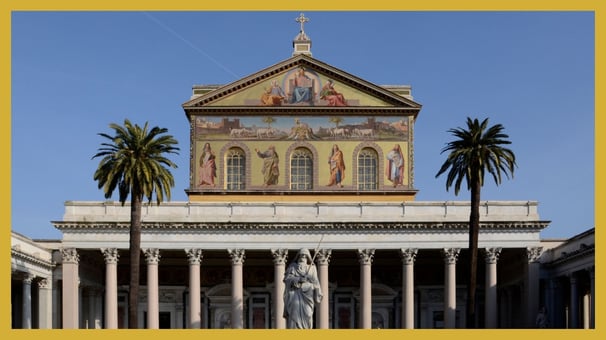

History
Erected near the tomb of the Apostle Paul, the Basilica of St. Paul Outside the Walls boasts a historically rich and diverse narrative, stretching across centuries and echoed in its remarkable architectural and artistic innovations.
The Ancient Basilica
Tracing its origins to the times when Christianity was proscribed within the Roman Empire, the site initially hosted a burial cell over the tomb of Apostle Paul, located near the Via Ostiense. This site swiftly became a focal point for pilgrimages and the faithful. Following the legalization of Christianity with the Edict of 313, Emperor Constantine the Great commissioned the construction of a grand basilica above the Apostle's tomb, consecrated in 324 under Pope Sylvester’s reign.
In 386, facing an ever-increasing influx of pilgrims and unable to relocate St. Paul’s tomb, Emperor Valentinian II ordered the basilica’s enlargement. The project, led by an official named Ciriade, resulted in an imposing structure featuring five aisles supported by eighty marble columns, reclaimed from earlier religious constructions. Although repeatedly plundered throughout its history, the basilica remained a pivotal pilgrimage destination. The mosaic in the apse, initiated under Pope Honorius III, epitomizes the persistent artistic dedication and spiritual significance of the basilica over centuries. Nevertheless, it suffered extensive damage from numerous events, including looting by the troops of Charles V in 1527 and various earthquakes.
The original basilica, established by Emperor Constantine, faced east near the Via Ostiense on the outskirts of ancient Rome. This location preserved its identity as a distinct worship site while remaining an integral part of the city. The subsequent basilica, realigned westward towards the Tiber River, upheld its position outside the city walls.
The Nineteenth-Century Reconstruction
A catastrophic fire in 1823 devastated much of the basilica, sparing only the transept, apse, ciborium, sections of the triumphal arch, and the cloister. The ensuing reconstruction, initiated by Pope Leo XII, was an expansive project that engaged numerous distinguished architects. Initially led by Giuseppe Valadier, the responsibility later transitioned to Pasquale Belli, Pietro Bosio, and Pietro Camporese the Younger. Subsequently, Luigi Poletti reimagined the design for the exterior, interior, and bell tower. The portico, a vision set forth by Virgilio Vespagnani and completed by Guglielmo Calderini, introduced an impressive monumental dimension to the basilica’s entrance.
The reconstruction was admired for its speed and professionalism yet criticized for its insensitivity toward the ancient Paleo-Christian basilica. Despite these criticisms, the basilica was restored to its former splendor, featuring a facade adorned with mosaics by Filippo Agricola and Nicola Consoni. Additionally, Luigi Poletti designed a new bell tower that replaced the 14th-century campanile.
The restoration resulted in the basilica acquiring a neoclassical design, distinguishing it from its Paleo-Christian origin while still reflecting the site's enduring historical and spiritual significance. Today, the Basilica of St. Paul Outside the Walls stands as a pivotal example of Roman ecclesiastical architecture and a beacon for pilgrims.
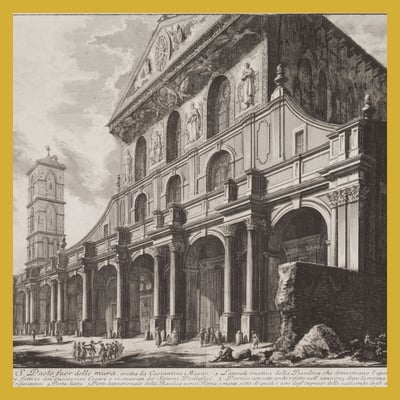

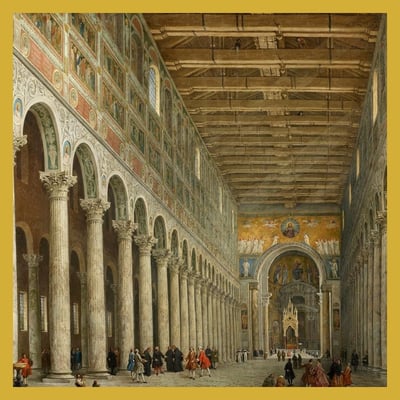

The Exterior of the Basilica
Situated beyond the ancient walls of Rome, the Basilica of St. Paul Outside the Walls ranks among the city’s most majestic sacred structures. Its grandeur is immediately apparent, marked by a square portico that offers pilgrims a solemn and harmonious welcome.
The Portico
Externally, the basilica emerges as an imposing neoclassical structure, showcasing architectural and artistic elements representative of its rich history. The portico, envisioned by Guglielmo Calderini and completed in 1928, forms a majestic 70 by 70-meter square, upheld by 150 granite columns. Central to this structure stands the statue of Saint Paul, meticulously crafted by Giuseppe Obici around 1850.
The Facade
The facade of the Basilica of St. Paul Outside the Walls exhibits a dynamic mosaic tableau created by the Vatican Mosaic Studio, from designs by Consoni and Agricola, executed between 1854 and 1874. This mosaic vividly portrays pivotal elements of Christian history across three horizontal bands. The lowest displays large figures of the major Old Testament prophets: Isaiah, Jeremiah, Ezekiel, and Daniel. The middle band features the mystical Lamb of God, flanked by Bethlehem and Jerusalem. Dominating the pediment at the top, Christ is exalted, accompanied by the Martyr Saints Peter and Paul.
The Holy Door
On the facade, the gilded bronze Holy Door, inaugurated by Cardinal Roger Etchegaray during the 2000 Jubilee, captures distinct attention. This door is adorned with three vertical panels, each symbolizing one of the three years leading up to the Jubilee, dedicated consecutively to the Father, the Holy Spirit, and the Son respectively. A Latin distich at the door’s base extends a warm welcome to pilgrims, blessing them with peace and eternal salvation.
The Cloister
The cloister, a quintessential example of the Cosmati style, commenced in 1205 and completed in 1240, crafted by the illustrious Roman marble cutters, the Vassalletto family. It comprises four arcades, framed by delicate columns which support rounded arches. These columns are embellished with mosaics and bas-reliefs, enhancing the surrounding garden area decorated with fragments from the ancient basilica, including Roman sarcophagi and other artifacts.
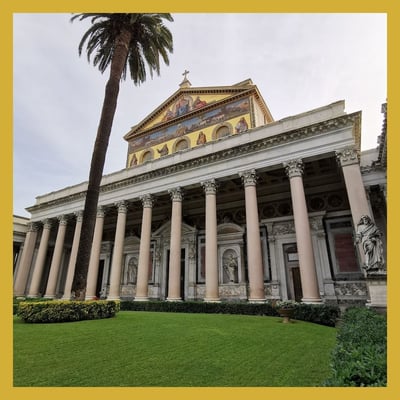

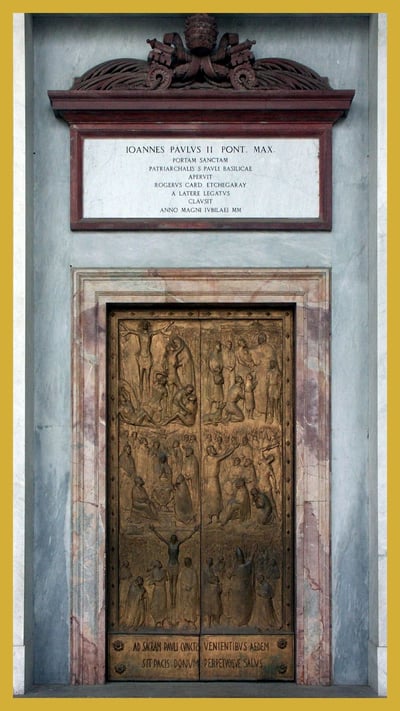

The Interior of the Basilica
The Basilica of St. Paul Outside the Walls captivates its visitors with a spacious and majestic interior that offers a spectacle of beauty.
Description
The interior is composed of five aisles, supported by eighty granite columns. The wooden ceiling of the central nave is embellished with gilded caissons set against a white background, featuring centrally the coat of arms of Pope Pius IX who spearheaded the basilica's reconstruction following the 1823 fire.
Prominent among the arts displayed are the apse mosaic, the ciborium, and a collection of 19th-century paintings that vividly portray episodes from the life of St. Paul. These paintings, crafted by a group of talented artists for the post-fire restoration, are prominently positioned between the windows of the central nave.
The Tomb of St. Paul
Beneath the main altar lies a large sarcophagus of unfinished marble, marking the spot where Emperor Constantine erected the first altar. The sarcophagus, obscured over centuries by additional constructions, was revealed during 2006 archaeological work which also uncovered the Constantinian apse, dating back to 324.
A 4th-century marble slab above the tomb carries the inscription "PAULUS APOSTOLUS MARTYR" (Paul, Apostle and Martyr). This tomb is now partially visible through a window behind the altar, permitting the faithful a closer view.
The Portraits of the Popes
One of the most evocative features inside the basilica is the chronological sequence of mosaic portraits of the popes, extending from St. Peter to Pope Francis along the friezes of the central and side aisles. Initiated in the 5th century by Pope Leo the Great (noted for his theological influence and defining the Papacy’s role in Rome), this tradition originally consisted of frescoes, segments of which are preserved in the adjacent convent. Post the 1823 fire, these were mostly recreated in mosaics by the Vatican Mosaic Studio between 1848 and 1876. These medallion-style portraits provide a visual journey through the history of the Church's spiritual leadership.
Mosaics and the Ciborium
In terms of mosaics, the apse features a monumental Byzantine-style piece executed by Venetian masters, with Christ Pantocrator at the center, flanked by Saints Luke, Paul, Peter, and Andrew. Below, the other apostles, along with evangelists Mark and Barnabas, are depicted singing the Gloria. The ciborium, designed by Arnolfo di Cambio in the 13th century, is a remarkable example of Gothic architecture. Supported by four porphyry columns, its intricate canopy is adorned with statuettes and bas-reliefs. Additionally, the triumphal arch mosaic, a gift from Galla Placidia and restored post the 442 earthquake, features a blessing Christ surrounded by the evangelists and the 24 Elders of the Apocalypse, enhancing the basilica’s historical and artistic continuum.
The Basilica of Saint Paul Outside the Walls hosts an extensive collection of artworks and relics that underscore its historical and religious significance. The Picture Gallery of the Basilica is a specialized space housing a diverse array of paintings, vestments, and sacred artefacts sourced from the archives and library of the Abbey of Saint Paul. Displayed items include intricately painted wooden panels and canvas paintings, together with a range of relics, one of which is a replica of a 9th-century manuscript Bible, known as the Carolingian Bible, a notable example of medieval scriptorial art.
Lapidary Museum
Situated in the arcades of the cloister, the Lapidary Museum contains numerous architectural fragments from the original basilica and roughly 2000 tombstone pieces inscribed in Greek or Latin. These artifacts were excavated from the nearby necropolis, which transitioned from pagan to Christian use over time. Noteworthy pieces include a 3rd-century Roman sarcophagus, later repurposed in the 12th century as the burial site for Pietro di Leoni.
Chapel of Relics
Within the Basilica, the Chapel of Relics holds some of the Church's most treasured relics, diligently safeguarded by the Benedictine monks. This chapel provides visitors with a unique opportunity to view and revere these sacred items, enhanced by detailed explanatory captions that elaborate on their origins and importance. With its rich artistic and spiritual legacy, the Basilica represents a focal point of immense interest for tourists and pilgrims alike, offering a profound experience intertwining faith and culture.
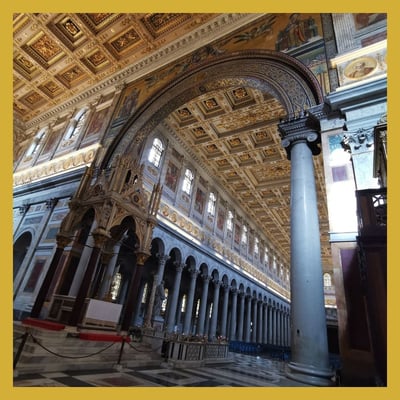

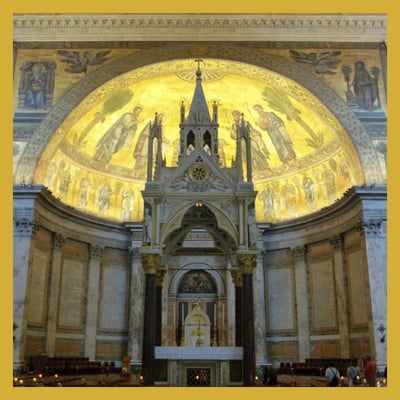

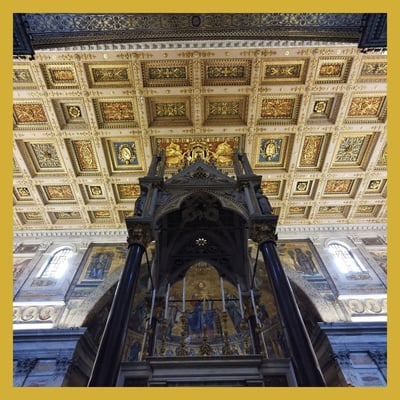

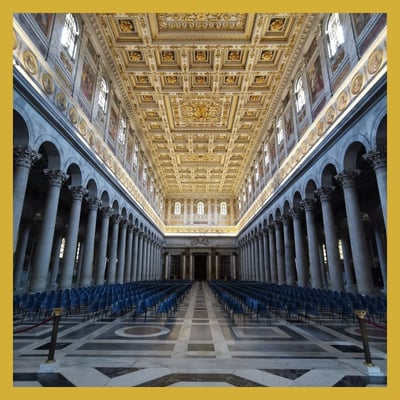

Drop us a line
Follow us
Discover the Jubilee
Experience the Jubilee
Jubilee locations
Get ready for the Jubilee
Rome and the Jubilee
